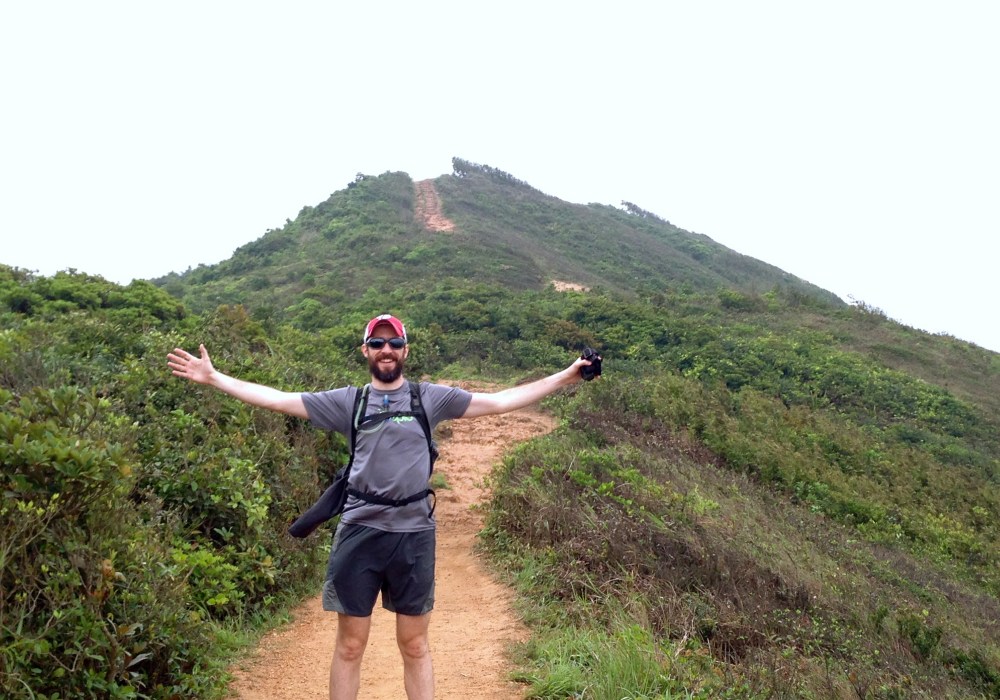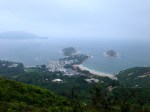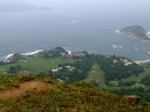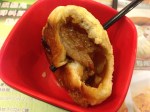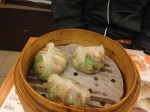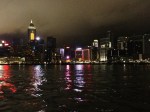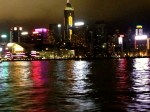Greetings from the future!
This dispatch comes to you from the financial hub of Asia — Hong Kong. There is so much to say about Hong Kong … where do I start? I know, with the 18-hour train ride from Shanghai that got us here. Up to this point, we’ve been spoiled by China’s high-speed train system — the G-train. It’s super clean, super smooth and super fast, averaging speeds of 124 mph. Sometimes, I found myself even wishing the train ride was a bit longer, like the 32 minute train ride from Suzhou to Shanghai.
Well, not this time. Anticipating the rise in prices that Hong Kong would bring and compensating for big spending nights in Shanghai, Chris and I decided to save a buck and take the slow train …
And boy-oh-boy was it slow … and smoky … and bumpy … and crowded, like six-person sleeper car crowded with entire elaborate family meals taking place on the bottom bunks. I was still recovering from a bad sheng jian bao incident in Shanghai (If you recall the doughy fried dumplings I raved about from Suzhou, I did not have the same love affair with Shanghai’s version, being that they made me violently ill.), so I quietly read my book from the top bunk whereas Chris joined in the festivities down below, feasting on duck, pickled vegetables and soybeans and downing bijou (rice wine). “Ganbei!” was shouted repeatedly, a cheers invoking you to empty your glass. Not surprisingly, the combination of pungent foods, rice wine and dozens of men smoking is not the best thing for a girl who recently reconfigured her digestive track.
Did I mention there was a fight? Before you start to worry, let me assure you we were in no danger. The fight was more theatre than legitimate threat; chest pounding of drunk, middle-aged men, and high pitched yelling from their wives. What went down exactly, we have no idea, but Chris and I, as well as the two American teachers we met (presently teaching in Abu Dhabi), tried our best to hide our laughter. It was a ridiculous and raucous scene.
But enough about the train, let’s talk about Hong Kong!
It’s impossible to describe Hong Kong without incorporating a bit of history. This is usually Chris’ area of expertise, but here’s my brief summary:
You probably know that the Brits ruled Hong Kong for a while, actually 156 years from 1841 – 1997. In 1841, China ceded Hong Kong, a sparsely populated island at the time, to Britain as a means of ending the first Opium War. The conflict had begun in 1839 when the British invaded China after China had attempted to suppress Britain’s opium trade (see Chris’ Shanghai post for more on opium’s influence in China). The British took over Hong Kong as a part of the Treaty of Nanjing, marking the beginning of the era of unequal treaties, a period in the 19th and 20th century where China was forced to handover control of many key territories (Chris wrote about this history previously in the post about Qingdao). As a British colony, Hong Kong thrived as an East-West trade point and epicenter of Western industry in Asia.
In 1898, China leased Hong Kong to the UK for an additional 99 years, and in 1997 rule over Hong Kong was peaceably transferred back to China on the condition that the Chinese communist party would maintain Hong Kong’s capitalist system, allowing Hong Kong to remain the financial center of Asia and thus creating the present status quo between China and Hong Kong as “one country, two systems.”
In short, Hong Kong is a lot like London but with much better weather.
So what does all this mean for our visit to Hong Kong? Western food at its finest! Pizza, pasta, tacos, burgers, fine dining or the best of comfort foods; it’s all here, it’s all good, and it’s all expensive. Our first night out, we gorged ourselves on gourmet pizza and red wine at an Italian restaurant in Lan Kwai Fong, a part of town celebrated for its culinary variety and nightlife. It was delicious and budget-wise comparable to a dinner out on 14th Street in D.C.
The most remarkable thing about Hong Kong is perhaps the very existence of this giant, lit-up metropolis, set smack dab in the middle of a wild, mountainous jungle. There is no other place like it that I’ve seen. We spent our days hiking on miles and miles of trails, and our nights out on the town, underdressed, weaving in and out of crowds of people from all over the world.
You want a suit? Ten men will offer to sell you one within 10 paces. You want a place to stay, this guy over here already has a room for you! Need to exchange money? Of course it’s not counterfeit! How about a watch? It’s fake, and that’s actually a selling point. Bottom line, there isn’t much you’ll want for in Hong Kong. Additionally, it’s a great place to load up on beauty products and over-the-counter medicine, being that they have an English-language pharmacy chain, Watson’s. [Note to female readers: much of the skin products (moisturizer, soap, sun tan lotion, etc.) in China and elsewhere in Asia have whitening agents in them, so this can make shopping for such things difficult if you are unable to read the labels.]
I’ve talked a lot about the Western food available in Hong Kong, but Eastern food shines here as well. Hong Kong is located across from mainland China’s Guangdong province, which was formally known as Canton. The people here speak Cantonese, not Mandarin like most of mainland China. Here is and interesting fact about Cantonese that I learned from Chris’ friend Chi-Kit, Hong Kong native currently living in Guangdong: The Cantonese language has nine tones whereas Mandarin only has five, making Cantonese the more complicated of the two. Chi-Kit took us to dinner one night (Thank you, Chi-Kit!), and he explained some of the nuances of the Cantonese language.
Now, back on the subject of food, Cantonese cuisine is the typical food in Hong Kong and the whole of Guangdong province. The most famous of Cantonese foods, at least in the West, is dim sum. This is China’s answer to Sunday brunch. Swap out eggs benedict for BBQ pork buns and mimosas for hot tea, and you have the same meal of friends and/or family getting together and stuffing their faces early in the day. [Some traditional places actually open as early as 5 a.m. and you can expect an elderly crowd at that hour.] We researched the best dim sum restaurants in Hong Kong and settled upon the restaurant crowned as the cheapest Michelin-starred restaurant in the world, Tim Ho Wan. A crowd of people were already waiting outside when we arrived but our wait only lasted a few minutes and soon after being seated the feasting began.
Here are some other interesting things about Hong Kong:
- Both Jackie Chan and Bruce Lee were born in Hong Kong. Kung Fu is a big deal. There is a statue of Bruce Lee on Hong Kong’s Avenue of Stars, which is comparable to Hollywood’s Walk of Fame. [Side note: We stayed at a hotel called Kung Fu Garden. There was a Kung Fu center on the main floor — no garden, however. Accommodations were not the best — did I mention how expensive Hong Kong is?]
- Hong Kong is made up of 235 islands. Hong Kong Island is the main one. We stayed on Kowloon, which was just a five-minute ferry ride away. The ferry is cheap and it runs back and forth, non-stop, for most of the day, so you never have to wait long. The ride at night with the lit-up city skyline is magical.
- There is a famous snake restaurant called She Wong Lam. At Chris’ charge, we set out for this restaurant. When we arrived, a live, caged snake greeted us at the door. Much to Chris’ dismay and my relief, we discovered that the place only serves food in the fall and winter seasons. Right now they just sell snake products purporting a range of medicinal qualities, with a heavy focus on virility. We were in it for the eats, so we left empty handed. I dodged snake for now, but there’s no shortage of snake eating in Southeast Asia, so I’m likely to be faced with this Fear Factor-esque meal again.
- Hiking and biking is great in Hong Kong. We spent a day hiking the Dragon’s Back trail on Hong Kong Island, ending the hike at Big Wave Bay, where we watched people surf as we rested on the beach. We spent another day hiking on Lantau Island.
- You don’t want to miss the view from Victoria Peak. The tram (like an incline) is a fun way to get up to the top but can entail brutal lines, especially on the weekend. You can also take a bus or just hoof it like Chris and I did. We then hiked from the top along the Hong Kong Trail. With all the great trails available, we ended up getting quite a bit of exercise during our stay. Hopefully that will help counteract all the pizza, wine and dim sum!
Check out our photos from Hong Kong:
